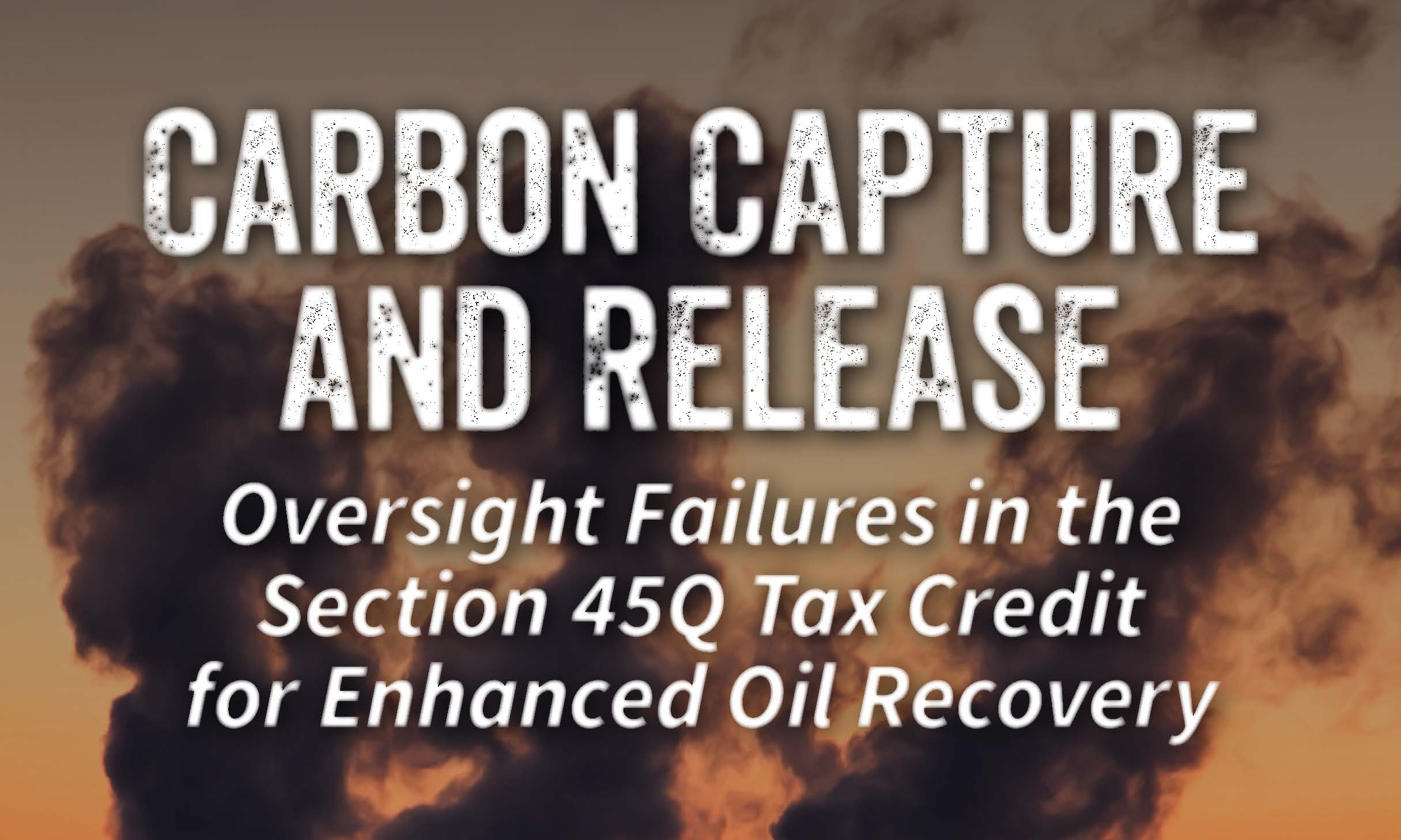Oversight Failures in the Section 45Q Tax Credit for Enhanced Oil Recovery
Executive Summary
After decades of scientific analysis and international negotiations, reducing carbon emissions is now a global imperative. U.S. Congress, for its part, recognized the potential for carbon capture and storage (CCS) technology to reduce emissions and provided a tax incentive for companies that capture carbon dioxide (CO2) from various industrial practices and store it underground.
The new tax policy, codified under Section 45Q of the Internal Revenue Code, offered a tax credit per ton of carbon captured and sold to companies to inject underground for permanent storage or for use in enhanced oil recovery (EOR). The intent was to jump start a nascent technology that could eventually transform into a globally scalable option to reduce emissions. In January 2018, Congress extended the credit, broadened the qualifying industries and tripled the amount offered for CO2 captured and sold to EOR companies.
Injecting captured carbon underground to produce more oil is promoted as a climate mitigation policy. Purportedly, over time oil fields could sequester (permanently store CO2 in geologic formations) large amounts of carbon and at the same time help bring down CCS technology costs. A popular notion is that the oil extracted and burned is less of a concern, as long as some carbon is permanently sequestered to help offset emissions elsewhere. The oil industry benefits from the enthusiasm for CCS because its growth strategy leans heavily on injecting CO2 to increase production. The industry plans to use CO2- EOR to unlock billions of barrels of oil trapped in vast residual oil zones. A consistent supply of cheap CO2 improves the extraction economics for resources that would otherwise likely remain in the ground.
In order to qualify for the tax credit under Section 45Q, a company must verify and report to the Environmental Protection Agency (EPA) that the carbon injected remains safely underground. Research into the tax credit reveals an alarming lack of oversight. EPA has no record of the vast majority of CO2 claimed under the credit. It appears some companies that benefited from the tax credit ignored monitoring and reporting requirements and continued to access the credit to their financial advantage. This report exposes these oversight failures and challenges the assertion that federal subsidies for carbon used in enhanced oil recovery could ever be considered an effective climate mitigation policy. Among the findings:
- 59,767,924: metric tons of CO2 claimed to IRS as captured for tax credit as of May 10, 2017.
- 3 million: metric tons of CO2 reported to EPA for sequestration verification as of August 5, 2017.
- $597 million up to $1.3 billion: value of claimed credits.
- 85%–90%: percentage of projects under the new tax credit that will be used to extract oil according to the International Energy Agency (IEA). Only 10%–15% would result in permanent sequestration of CO2.
- 375 million barrels: increase in oil production annually by 2030 as a result of carbon capture technology and infrastructure deployment.
The discrepancy between the IRS and EPA data suggests that only a small portion of the required reporting to EPA to ensure that the carbon is verifiably and permanently stored underground is occurring.
Verification that CO2 is actually sequestered is critical to demonstrating the effectiveness of CCS as an emissions reduction technology. Ensuring secure geological storage is a large part of the bipartisan support for the tax credit. Proponents want to incentivize sequestration, not merely injection for oil extraction. The tax policy is designed so that EOR operations have to confirm by monitoring, reporting and verifying that these projects provide the intended carbon storage benefit. This did not happen.
Ignoring compliance provided industry an unearned advantage in the marketplace. If it is not remedied the increase in tax credits will only exacerbate oversight issues and undermine the competiveness of zero carbon alternatives. Instead, a small group of oil companies are attempting to further weaken the tax credit requirements. Legislation supported by Exxon Mobil and Denbury Resources sought to change what is considered secure geological storage. So far these attempts have not been successful, but there have been ongoing efforts to weaken the 45Q requirements even after the tax credit was increased. This undercuts the largely good-faith efforts to develop sound CCS policy.
In light of the credit extension, lawmakers should grant Section 45Q additional scrutiny, provide resources necessary to hold bad actors accountable, and restore public trust in the process of geologic sequestration. The relatively small universe of companies that capture carbon combined with the limited number of companies that injected carbon to enhance oil recovery from 2011–2018 should make it easy for regulators to identify those who are skirting the rules.
- Until the tax credit oversight is reformed, Congress should:
- Enact a moratorium on all Section 45Q tax credits for CO2 used in enhanced oil recovery.
- Ensure projects out of compliance since 2011 submit a Monitoring Reporting and Verification plan to EPA or halt injection.
- The Senate Finance and Environment and Public Works Committees should hold hearings on past and future oversight of 45Q.
- Begin a stakeholder process to create a credible regulatory framework for CO2–EOR designed to reflect the unique risks associated with the injection of carbon and to ensure geologic sequestration.
